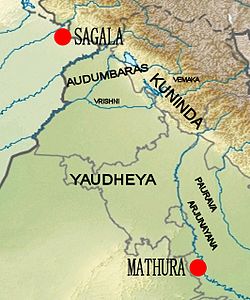
Back Vrisni Spanish वृष्णि Hindi Wresni ID Wresni JV ವೃಷ್ಣಿ Kannada 브리슈니 Korean वृष्णि Nepali Вришни Russian यदुकुलम् Sanskrit விருஷ்ணி குலம் Tamil
Vrishnis | |||||||
|---|---|---|---|---|---|---|---|
| 5th century BCE–4th century CE | |||||||
Silver coin of a "King Vrishni" (of the Audumbaras according to Cunningham).[1][2]
Obv Pillar with half-lion and half-elephant, surmounted by a Triratna symbol and surrounded by Buddhist railing. Brahmi legend Vṛishṇi Raja jnâgaṇyasya blubharasya Rev Large Dharmachakra symbol. Kharosthi legend Vrishni Raja jnâganyasya blubharasya.[1] | |||||||
Location on the Vrishnis and contemporary South Asian polities circa 150 CE.[3] | |||||||
 Location of the Vrishni among other groups: the Audumbaras, the Kunindas, the Vemakas, the Yaudheyas, the Pauravas and the Arjunayanas. | |||||||
| Capital | Prakritanak Nagar | ||||||
| Government | Republic | ||||||
| History | |||||||
• Established | 5th century BCE | ||||||
• Disestablished | 4th century CE | ||||||
| |||||||
The Vrishnis (Sanskrit: वृष्णि, IAST: Vṛṣṇi) were an ancient Vedic Indian clan who were believed to be the descendants of Vrishni. It is believed that Vrishni was the son of Satvata, a descendant of Yadu, the son of Yayati. He had two wives, Gandhari and Madri, not to be confused with Gandhari and Madri from the Mahabharata. He has a son named Devamidhusha by his wife Madri. Vasudeva, the father of Krishna was the grandson of Devamidhusha.[4] According to the Puranas, the Vrishnis were residents of Dvaraka.
- ^ a b Alexander Cunningham's Coins of Ancient India: From the Earliest Times Down to the Seventh Century (1891) p.70 [1]
- ^ Ph.D, Lavanya Vemsani (2016). Krishna in History, Thought, and Culture: An Encyclopedia of the Hindu Lord of Many Names: An Encyclopedia of the Hindu Lord of Many Names. ABC-CLIO. p. 296. ISBN 978-1-61069-211-3.
- ^ Schwartzberg, Joseph E. (1978). A Historical atlas of South Asia. Chicago: University of Chicago Press. p. 145, map XIV.1 (d). ISBN 0226742210.
- ^ Pargiter F.E. (1922, reprint 1972). Ancient Indian Historical Tradition, Delhi: Motilal Banarsidass, pp.103-7
© MMXXIII Rich X Search. We shall prevail. All rights reserved. Rich X Search
![Silver coin of a "King Vrishni" (of the Audumbaras according to Cunningham).[1][2] Obv Pillar with half-lion and half-elephant, surmounted by a Triratna symbol and surrounded by Buddhist railing. Brahmi legend Vṛishṇi Raja jnâgaṇyasya blubharasya Rev Large Dharmachakra symbol. Kharosthi legend Vrishni Raja jnâganyasya blubharasya.[1] of](http://upload.wikimedia.org/wikipedia/commons/thumb/9/9f/Vrishni_coin.png/300px-Vrishni_coin.png)
